Child Psychology: Wooden Blocks Toy Analysis for Early Childhood
VerifiedAdded on 2022/08/20
|5
|858
|209
Homework Assignment
AI Summary
This assignment analyzes wooden blocks as a toy suitable for early childhood, focusing on their developmental impact. The analysis identifies the toy, wooden blocks, and describes its features. It specifies the appropriate age range (18 months to 3 years) and highlights the cognitive, physical, and social domains of development stimulated by the toy. The assignment details how wooden blocks facilitate fine and gross motor skills through gripping and manipulating activities. Safety concerns, such as potential hazards from unfinished blocks, are also discussed. References from relevant research papers support the analysis, emphasizing the importance of wooden blocks in fostering children's cognitive skills, social interaction, and overall development.
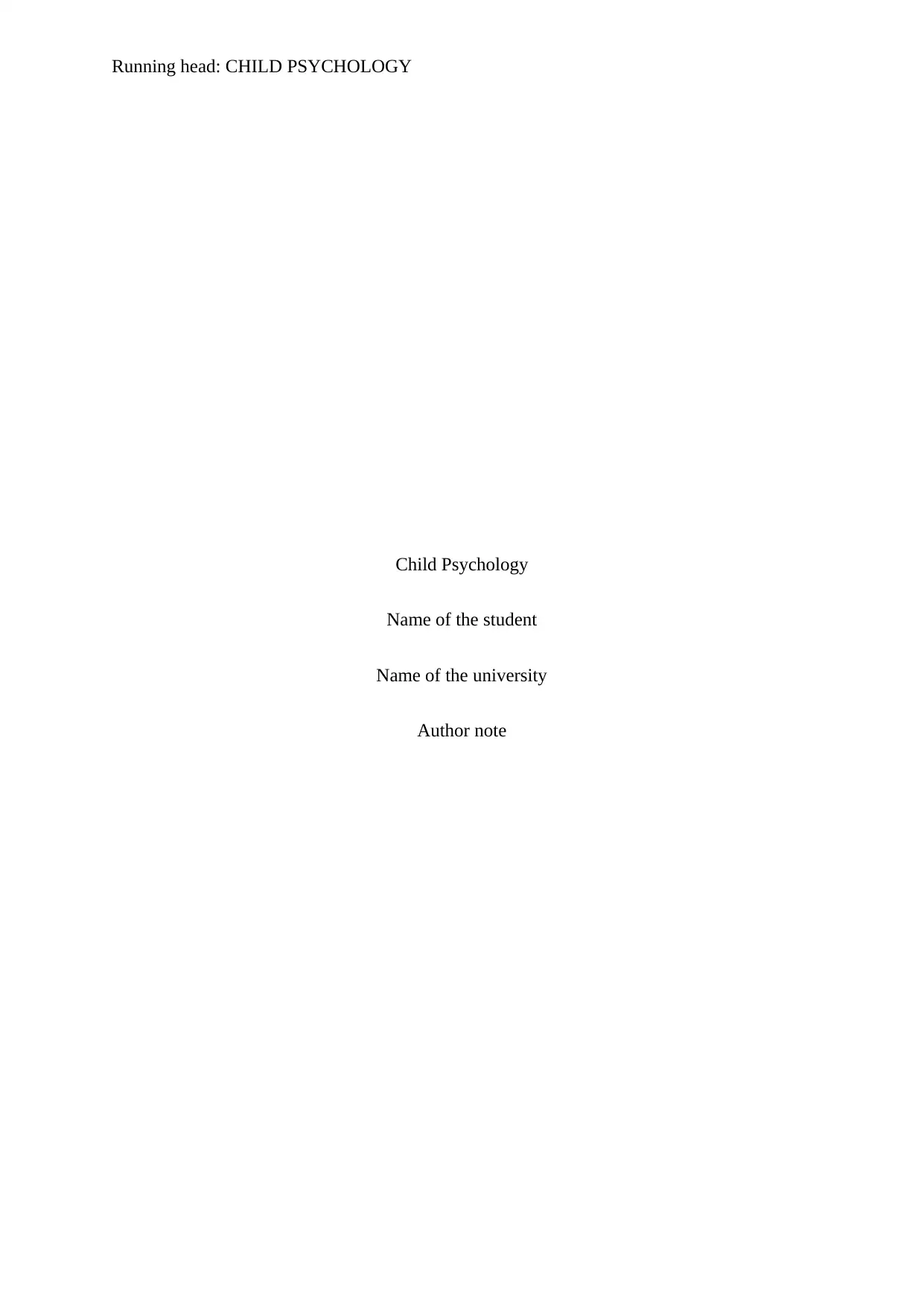
Running head: CHILD PSYCHOLOGY
Child Psychology
Name of the student
Name of the university
Author note
Child Psychology
Name of the student
Name of the university
Author note
Paraphrase This Document
Need a fresh take? Get an instant paraphrase of this document with our AI Paraphraser
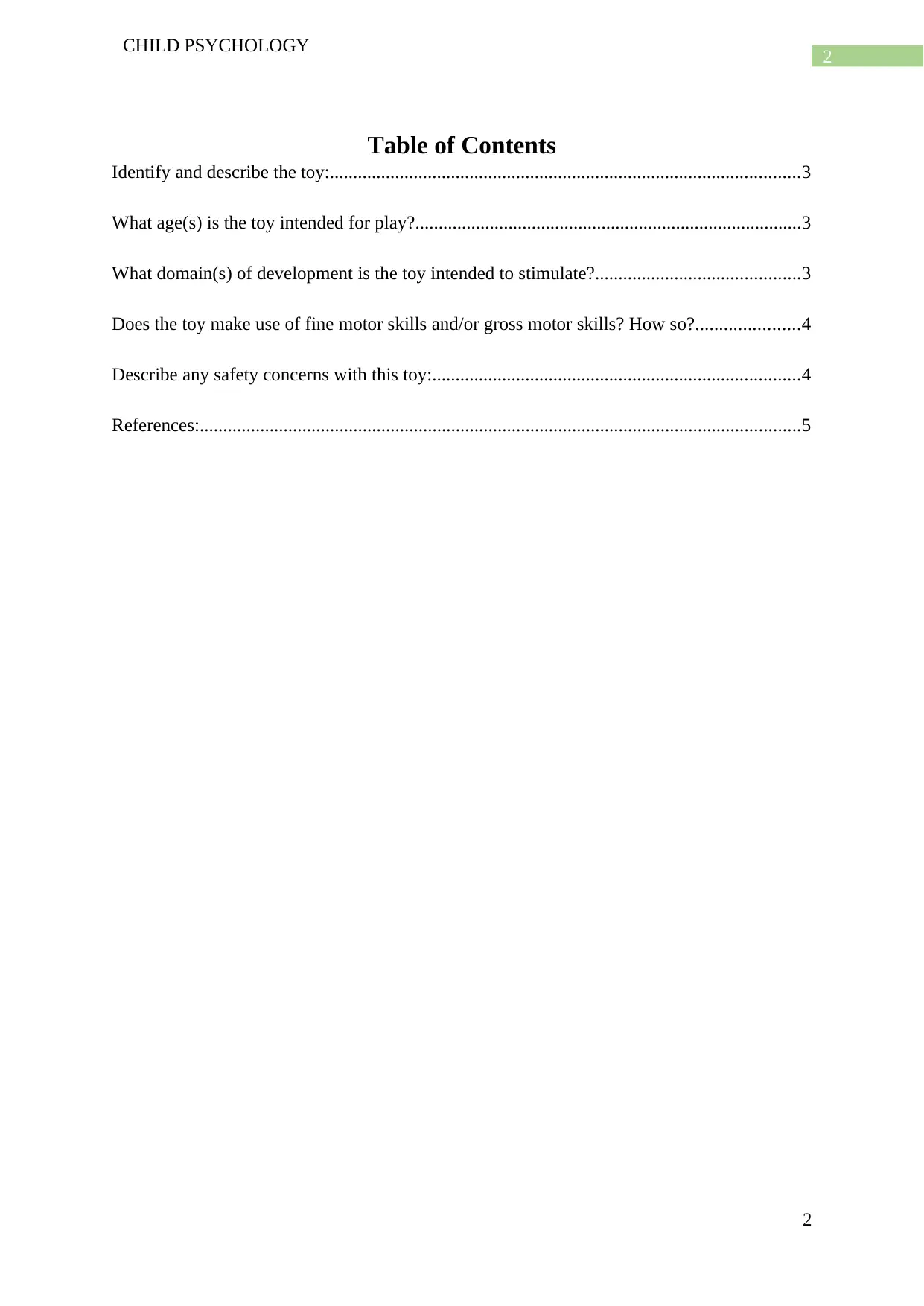
2
CHILD PSYCHOLOGY
Table of Contents
Identify and describe the toy:.....................................................................................................3
What age(s) is the toy intended for play?...................................................................................3
What domain(s) of development is the toy intended to stimulate?............................................3
Does the toy make use of fine motor skills and/or gross motor skills? How so?......................4
Describe any safety concerns with this toy:...............................................................................4
References:.................................................................................................................................5
2
CHILD PSYCHOLOGY
Table of Contents
Identify and describe the toy:.....................................................................................................3
What age(s) is the toy intended for play?...................................................................................3
What domain(s) of development is the toy intended to stimulate?............................................3
Does the toy make use of fine motor skills and/or gross motor skills? How so?......................4
Describe any safety concerns with this toy:...............................................................................4
References:.................................................................................................................................5
2
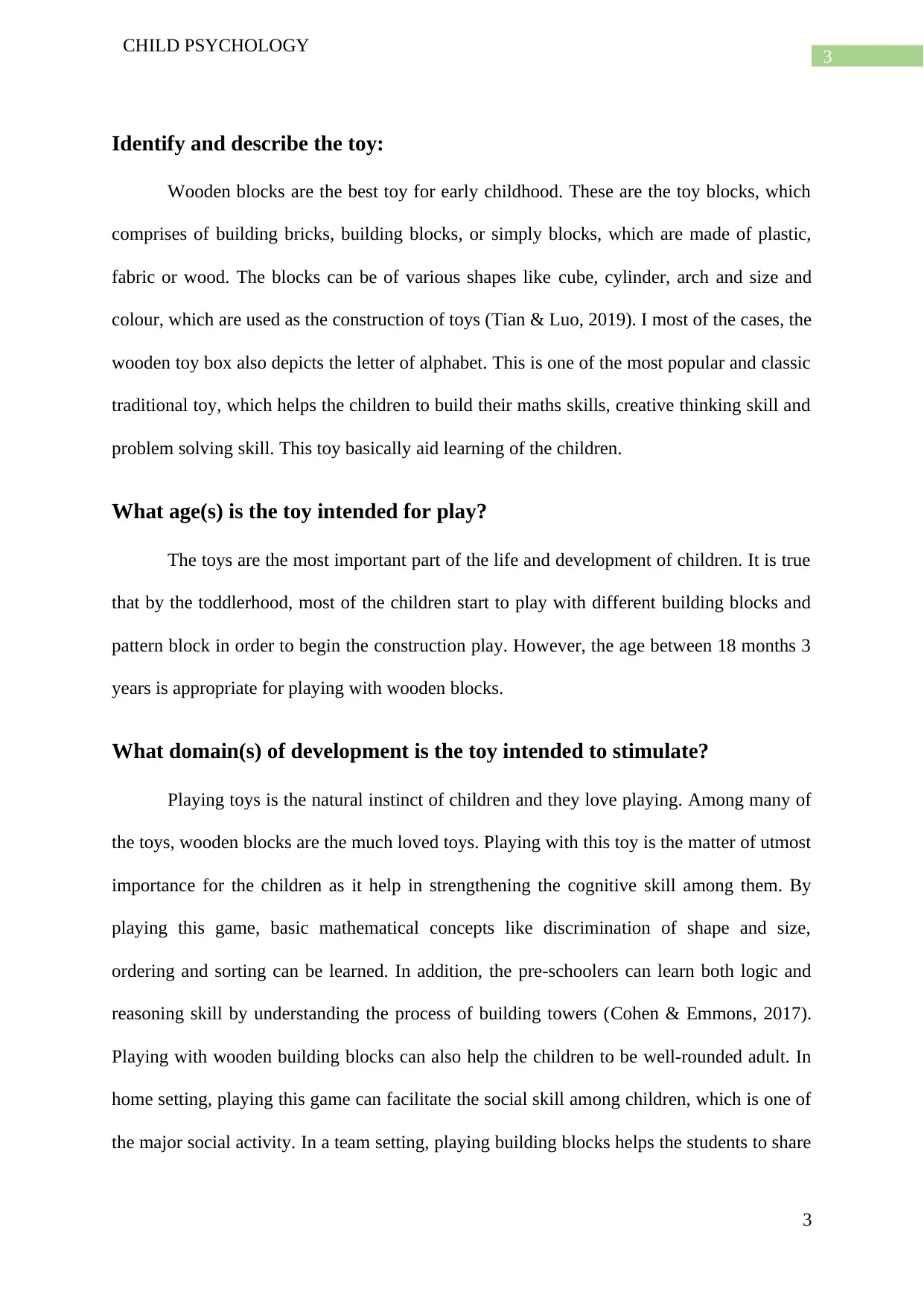
3
CHILD PSYCHOLOGY
Identify and describe the toy:
Wooden blocks are the best toy for early childhood. These are the toy blocks, which
comprises of building bricks, building blocks, or simply blocks, which are made of plastic,
fabric or wood. The blocks can be of various shapes like cube, cylinder, arch and size and
colour, which are used as the construction of toys (Tian & Luo, 2019). I most of the cases, the
wooden toy box also depicts the letter of alphabet. This is one of the most popular and classic
traditional toy, which helps the children to build their maths skills, creative thinking skill and
problem solving skill. This toy basically aid learning of the children.
What age(s) is the toy intended for play?
The toys are the most important part of the life and development of children. It is true
that by the toddlerhood, most of the children start to play with different building blocks and
pattern block in order to begin the construction play. However, the age between 18 months 3
years is appropriate for playing with wooden blocks.
What domain(s) of development is the toy intended to stimulate?
Playing toys is the natural instinct of children and they love playing. Among many of
the toys, wooden blocks are the much loved toys. Playing with this toy is the matter of utmost
importance for the children as it help in strengthening the cognitive skill among them. By
playing this game, basic mathematical concepts like discrimination of shape and size,
ordering and sorting can be learned. In addition, the pre-schoolers can learn both logic and
reasoning skill by understanding the process of building towers (Cohen & Emmons, 2017).
Playing with wooden building blocks can also help the children to be well-rounded adult. In
home setting, playing this game can facilitate the social skill among children, which is one of
the major social activity. In a team setting, playing building blocks helps the students to share
3
CHILD PSYCHOLOGY
Identify and describe the toy:
Wooden blocks are the best toy for early childhood. These are the toy blocks, which
comprises of building bricks, building blocks, or simply blocks, which are made of plastic,
fabric or wood. The blocks can be of various shapes like cube, cylinder, arch and size and
colour, which are used as the construction of toys (Tian & Luo, 2019). I most of the cases, the
wooden toy box also depicts the letter of alphabet. This is one of the most popular and classic
traditional toy, which helps the children to build their maths skills, creative thinking skill and
problem solving skill. This toy basically aid learning of the children.
What age(s) is the toy intended for play?
The toys are the most important part of the life and development of children. It is true
that by the toddlerhood, most of the children start to play with different building blocks and
pattern block in order to begin the construction play. However, the age between 18 months 3
years is appropriate for playing with wooden blocks.
What domain(s) of development is the toy intended to stimulate?
Playing toys is the natural instinct of children and they love playing. Among many of
the toys, wooden blocks are the much loved toys. Playing with this toy is the matter of utmost
importance for the children as it help in strengthening the cognitive skill among them. By
playing this game, basic mathematical concepts like discrimination of shape and size,
ordering and sorting can be learned. In addition, the pre-schoolers can learn both logic and
reasoning skill by understanding the process of building towers (Cohen & Emmons, 2017).
Playing with wooden building blocks can also help the children to be well-rounded adult. In
home setting, playing this game can facilitate the social skill among children, which is one of
the major social activity. In a team setting, playing building blocks helps the students to share
3
⊘ This is a preview!⊘
Do you want full access?
Subscribe today to unlock all pages.

Trusted by 1+ million students worldwide
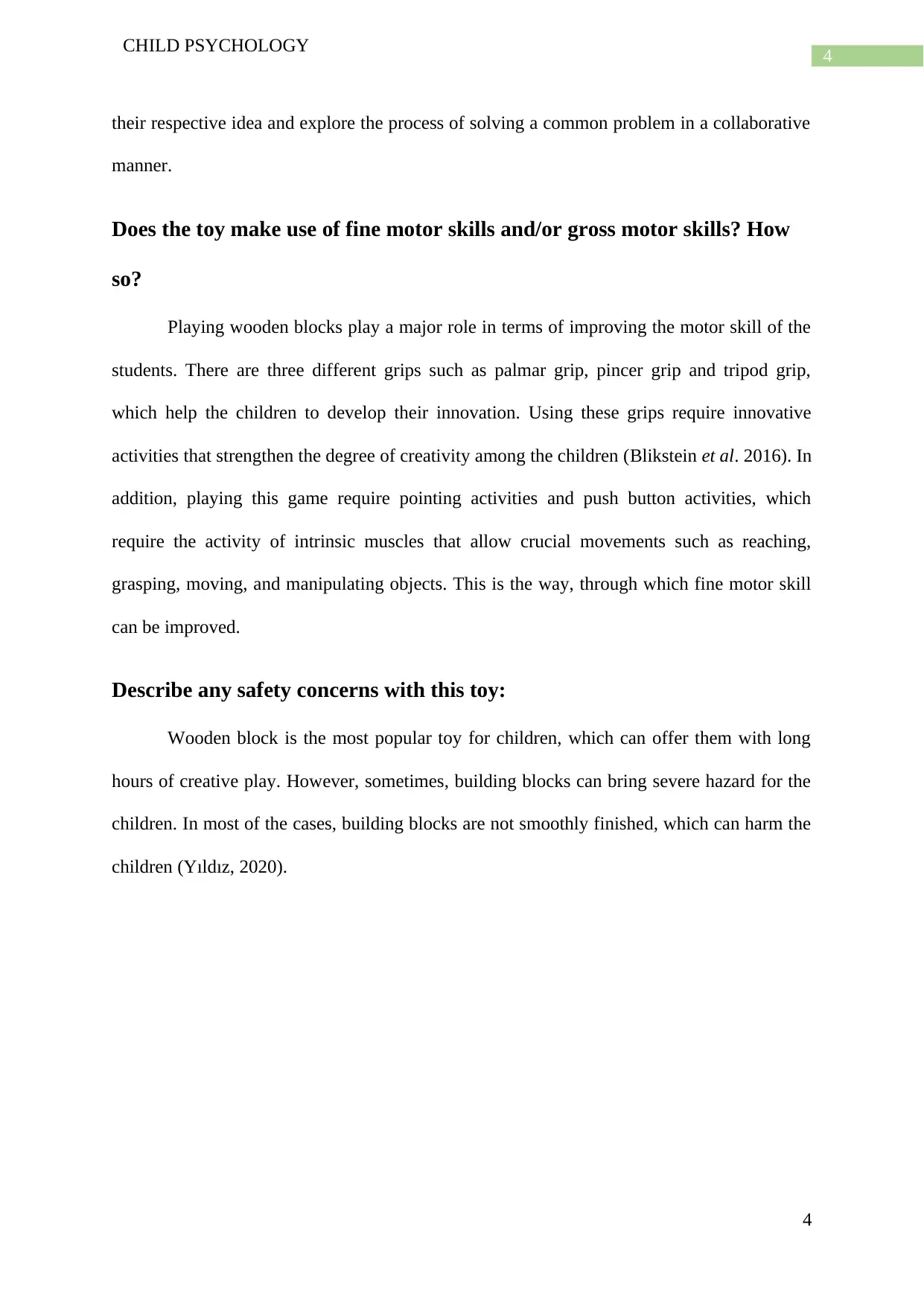
4
CHILD PSYCHOLOGY
their respective idea and explore the process of solving a common problem in a collaborative
manner.
Does the toy make use of fine motor skills and/or gross motor skills? How
so?
Playing wooden blocks play a major role in terms of improving the motor skill of the
students. There are three different grips such as palmar grip, pincer grip and tripod grip,
which help the children to develop their innovation. Using these grips require innovative
activities that strengthen the degree of creativity among the children (Blikstein et al. 2016). In
addition, playing this game require pointing activities and push button activities, which
require the activity of intrinsic muscles that allow crucial movements such as reaching,
grasping, moving, and manipulating objects. This is the way, through which fine motor skill
can be improved.
Describe any safety concerns with this toy:
Wooden block is the most popular toy for children, which can offer them with long
hours of creative play. However, sometimes, building blocks can bring severe hazard for the
children. In most of the cases, building blocks are not smoothly finished, which can harm the
children (Yıldız, 2020).
4
CHILD PSYCHOLOGY
their respective idea and explore the process of solving a common problem in a collaborative
manner.
Does the toy make use of fine motor skills and/or gross motor skills? How
so?
Playing wooden blocks play a major role in terms of improving the motor skill of the
students. There are three different grips such as palmar grip, pincer grip and tripod grip,
which help the children to develop their innovation. Using these grips require innovative
activities that strengthen the degree of creativity among the children (Blikstein et al. 2016). In
addition, playing this game require pointing activities and push button activities, which
require the activity of intrinsic muscles that allow crucial movements such as reaching,
grasping, moving, and manipulating objects. This is the way, through which fine motor skill
can be improved.
Describe any safety concerns with this toy:
Wooden block is the most popular toy for children, which can offer them with long
hours of creative play. However, sometimes, building blocks can bring severe hazard for the
children. In most of the cases, building blocks are not smoothly finished, which can harm the
children (Yıldız, 2020).
4
Paraphrase This Document
Need a fresh take? Get an instant paraphrase of this document with our AI Paraphraser
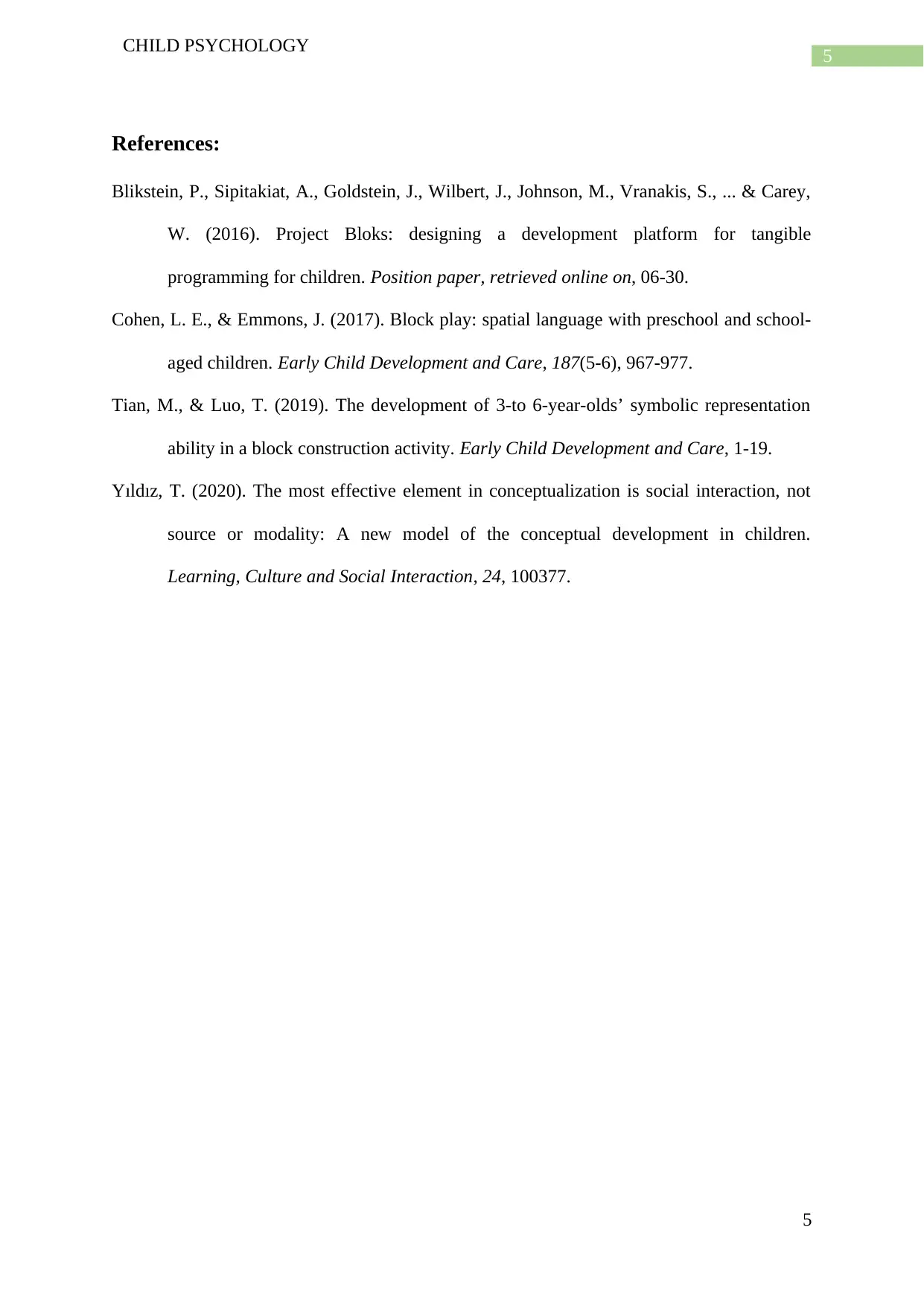
5
CHILD PSYCHOLOGY
References:
Blikstein, P., Sipitakiat, A., Goldstein, J., Wilbert, J., Johnson, M., Vranakis, S., ... & Carey,
W. (2016). Project Bloks: designing a development platform for tangible
programming for children. Position paper, retrieved online on, 06-30.
Cohen, L. E., & Emmons, J. (2017). Block play: spatial language with preschool and school-
aged children. Early Child Development and Care, 187(5-6), 967-977.
Tian, M., & Luo, T. (2019). The development of 3-to 6-year-olds’ symbolic representation
ability in a block construction activity. Early Child Development and Care, 1-19.
Yıldız, T. (2020). The most effective element in conceptualization is social interaction, not
source or modality: A new model of the conceptual development in children.
Learning, Culture and Social Interaction, 24, 100377.
5
CHILD PSYCHOLOGY
References:
Blikstein, P., Sipitakiat, A., Goldstein, J., Wilbert, J., Johnson, M., Vranakis, S., ... & Carey,
W. (2016). Project Bloks: designing a development platform for tangible
programming for children. Position paper, retrieved online on, 06-30.
Cohen, L. E., & Emmons, J. (2017). Block play: spatial language with preschool and school-
aged children. Early Child Development and Care, 187(5-6), 967-977.
Tian, M., & Luo, T. (2019). The development of 3-to 6-year-olds’ symbolic representation
ability in a block construction activity. Early Child Development and Care, 1-19.
Yıldız, T. (2020). The most effective element in conceptualization is social interaction, not
source or modality: A new model of the conceptual development in children.
Learning, Culture and Social Interaction, 24, 100377.
5
1 out of 5
Related Documents
Your All-in-One AI-Powered Toolkit for Academic Success.
+13062052269
info@desklib.com
Available 24*7 on WhatsApp / Email
![[object Object]](/_next/static/media/star-bottom.7253800d.svg)
Unlock your academic potential
Copyright © 2020–2025 A2Z Services. All Rights Reserved. Developed and managed by ZUCOL.





